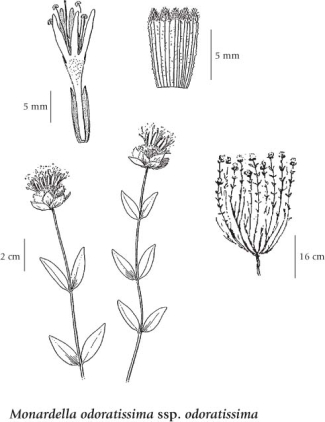Monardella odoratissima subsp. discolor Benth.
monardella (mountain monardella)
Lamiaceae (Mint family)
Introduction to Vascular Plants
monardella (mountain monardella)
Lamiaceae (Mint family)
Introduction to Vascular Plants
Map
Distribution of Monardella odoratissima subsp. discolor
Click here to view the full interactive map and legend
Species Information
General:
Perennial herb from a stout taproot and branching woody stem-base; stems numerous, loosely ascending or erect, simple or nearly so, 10-50 cm tall, 4-angled; hairy, sometimes with gland-tipped bristles.
Leaves:
Opposite, firm, lanceolate to egg-shaped, 1-3.5 cm long, 3-12 mm wide, entire, sparsely to densely hairy, green to ash-grey, often purple-tinged; short-stalked or almost unstalked.
Flowers:
Inflorescence a single, terminal, head-like cluster, 1-4 cm wide, closely surrounded by leaf-like bracts; bracts conspicuous, 7-15 mm long, lanceolate to egg-shaped, hairy, rather dry, veiny, more or less purplish-tinged, long-hairy on the margins, tips pointed to rounded; outer bracts bent back or spreading, inner bracts forming a cup-like involucre; corollas tubular, pink-purple to whitish, 1-2 cm long, the 2 lips almost equal, about half as long as the tube, the upper lip erect, 2-lobed, the lower lip bent back, 3-lobed; calyces hairy, the short teeth woolly-hairy.
Fruits:
Nutlets, 4 clustered together.
Illustration

If more than one illustration is available for a species (e.g., separate illustrations were provided for two subspecies) then links to the separate images will be provided below. Note that individual subspecies or varietal illustrations are not always available.
Illustration Source: The Illustrated Flora of British Columbia
Habitat and Range
Dry shrublands in the steppe and montane zones; rare in SE BC east of the Coast-Cascade Mountains, known only from Nelson; S to CA, NM and CO.Status Information
Synonyms
Synonyms and Alternate Names:
Monardella odoratissima subsp. euodoratissima Epling
Monardella odoratissima subsp. odoratissima Benth.
Monardella odoratissima var. neglecta Cronq.
